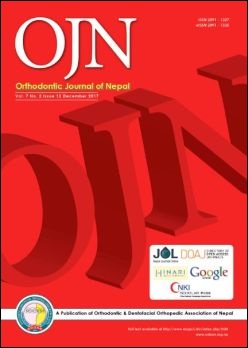Cephalic Index among Nepalese Medical Students
DOI:
https://doi.org/10.3126/ojn.v7i2.20159Keywords:
brachycephalic, cephalic index, dolicocephalic, hyperbrachycephalic, mesocephalicAbstract
Introduction: Cephalic index is race and sex specific parameter. Morphology of all living beings undergoes changes in varying degrees during their life and the features are variable in the individuals of the same species.
Objective: To measure the head size of the Nepalese medical students of both sexes between 18 to 24 years of age, to determine the different head type and to explore the distribution of cephalic index by ethnicity.
Materials & Method: Materials used were a Spreading caliper and a measuring scale. The method used for assessing cephalic index was Hrdlicka’s method.
Result: The result showed that the majority of the medical students of Nepal Medical College had typical Brachycephalic head type.
Conclusion: The dominant type of head shape revealed was brachycephalic and the least common head type as Dolicocephalic in Nepalese medical students of all the three ethnic groups namely Brahmin, Newar and Chettri.
Downloads
Downloads
Published
How to Cite
Issue
Section
License
Copyright © held by Orthodontic & Dentofacial Orthopedic Association of Nepal
- Copyright on any research article is transferred in full to the Orthodontic & Dentofacial Orthopedic Association of Nepal upon publication in the journal. The copyright transfer includes the right to reproduce and distribute the article in any form of reproduction (printing, electronic media or any other form).
- Articles in the Orthodontic Journal of Nepal are Open Access articles published under the Creative Commons CC BY License (https://creativecommons.org/licenses/by/4.0/)
- This license permits use, distribution and reproduction in any medium, provided the original work is properly cited.




